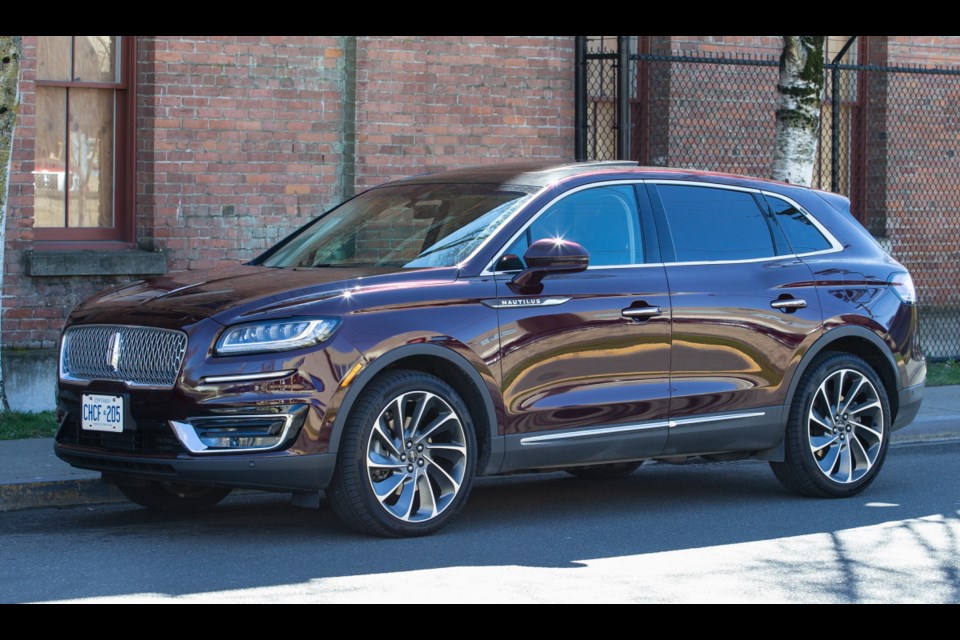Step into a world of luxury with the 2019 Lincoln Nautilus. We’re not talking about the European version of luxury, which can be slightly cold and clinical, but the North American ideal of luxury that pampers and coddles.
If you think the Nautilus seems vaguely familiar, you are correct: It was recently called the MKX. Lincoln has recently decided to drop the MK moniker in favour of actual names for its vehicles.
This five-passenger mid-sized SUV/crossover sits under the full-size Navigator in Lincoln’s lineup.
For 2019, the vehicle received a mid-cycle refresh, and with it came the new name and a new grille to reflect a new corporate design signature that has already begun on the rest of the fleet.
If you still get the feeling that it still reminds you of other Fords, you get bragging rights at parties, as the Nautilus, even with designer clothes and high levels of standard features, shares a lineage with the Ford Edge (reviewed last week).
The Nautilus is available in two trim levels, the base Select, which starts at $48,950, and the up-level Reserve, at $55,350. I drove a loaded example of the latter, with a list price of $71,150, thanks to $15,800 in options.
The Lincoln experience begins as you near the vehicle. The vehicle senses the key in your pocket or purse as you approach. When the sun goes down, it reacts by turning on the parking lights and illuminating the ground around the doors — the lamp hidden under the front outside mirrors even projects the Lincoln logo on the ground.
It is easy to imagine the cabin of the Nautilus as an extension of your home, especially if your home is a sanctuary of leather and wood. Your world is immediately more serene, thanks to acoustically lined glass and more than enough sound insulation to keep out any unwanted noise. If that is not enough, you can turn on (no need to crank up, either) the Revel II audio system with its 19 high-fidelity speakers.
My tester came with an optional 22-way power driver seat with 11 air cushions and seven massage programs to choose from, from relaxing to invigorating. Throw in the option of heat or ventilation functions, and you won’t want to leave your vehicle even after you reach your destination.
Navigating the urban jungle is never easy, with its many potholes, curbs and pedestrians. The Technology package gave me park-aid sensors and a 360-degree camera showed their usefulness. Sensors warned me of rear cross-traffic, the sonar warned me if I was too close to an object in the front and the front camera allowed me to get a panoramic view of pedestrians and traffic (in the front) when needed.
The Driver Assistance package endows the Nautilus with lane-keep assist, adaptive steering, collision warning and collision avoidance (all of which I did not attempt to test).
A forward-looking radar and camera works in tandem for the Lane Centring Assist feature.
The Nautilus comes standard with a turbocharged 2.0-litre four-cylinder engine. For an extra $3,000, you get an optional twin-turbocharged 2.7-litre V-6 unit that produces 335 horsepower and 380 pound-feet of torque. The unit is mated to a smooth-shifting eight-speed automatic and all-wheel drive.
Bury the pedal to the metal and the Nautilus really scoots, with a 0-100 km/h dash in about 6.5 seconds.
How much power you muster up depends on you and your choice of fuels.
With sensors and electronic engine management, the grade of fuel you choose determines how fast you can go.
If you are looking for maximum power, you need to give it a diet of premium. You can, on the other hand, choose to save a few dollars every fill-up by choosing regular octane gas. The engine will run just fine — you just sacrifice a few horses in the process.
With engine stop/start technology, the Nautilus returns 12.6 litres per 100 kilometres in the city and 9.2 on the highway.
The interior is where the Nautilus shines. It surrounds you with upscale materials and plush surfaces. The dash has an organic, flowing shape, devoid of edges. Even switches, including the push-button start, are embedded into the form.
While styled, it is still functional, with a centre console hollowed out for storage for appointment books or purses, and your phone gets its own wireless charging tray.
The infotainment system features an eight-inch screen that serves as the go-to place for audio, navigation, telephone and climate control.
Most controls can be accessed via the touchscreen or voice activation. Some controls, such as the heated and ventilated seats, have redundant, physical buttons on the dash, but others, such as the heated steering wheel, can only be found on the screen.
The button to activate the massage function is found on the side of the seat.
Lincoln is no stranger to the luxury game, and the Nautilus delivers in a keenly competitive segment.
THE SPEC SHEET
Type: Mid-sized luxury SUV/crossover, front engine, all-wheel drive
Engine: Twin-turbocharged 2.7-litre V-6, 335 hp at 5,500 rpm, 380 lb.-ft. of torque at 3,250 rpm
Transmission: Eight-speed automatic
Dimensions (mm): Length, 4,826; width, 1,933; height, 1,681; wheelbase, 2,850
Curb weight (kg): 1,990
Price (base/as tested): $55,350/ $73,150 (includes $2,000 freight and PDI and $100 AC tax)
Options: Metallic paint $700, 2.7-litre V-6 $3,000, cargo utility package $350, technology package $1,100, driver assistance package $2,500, Ultimate package $5,500, interior protection package $450, tow package $500, 22-way power driver seat $1,600
Tires: 265/40 R21 tires on alloy wheels
Fuel type: Regular/premium
Fuel economy (L/100km): 12.6 city/ 9.2 highway
Warranty: Four years/80,000 km new car, six years/110,000 km powertrain and roadside assistance



